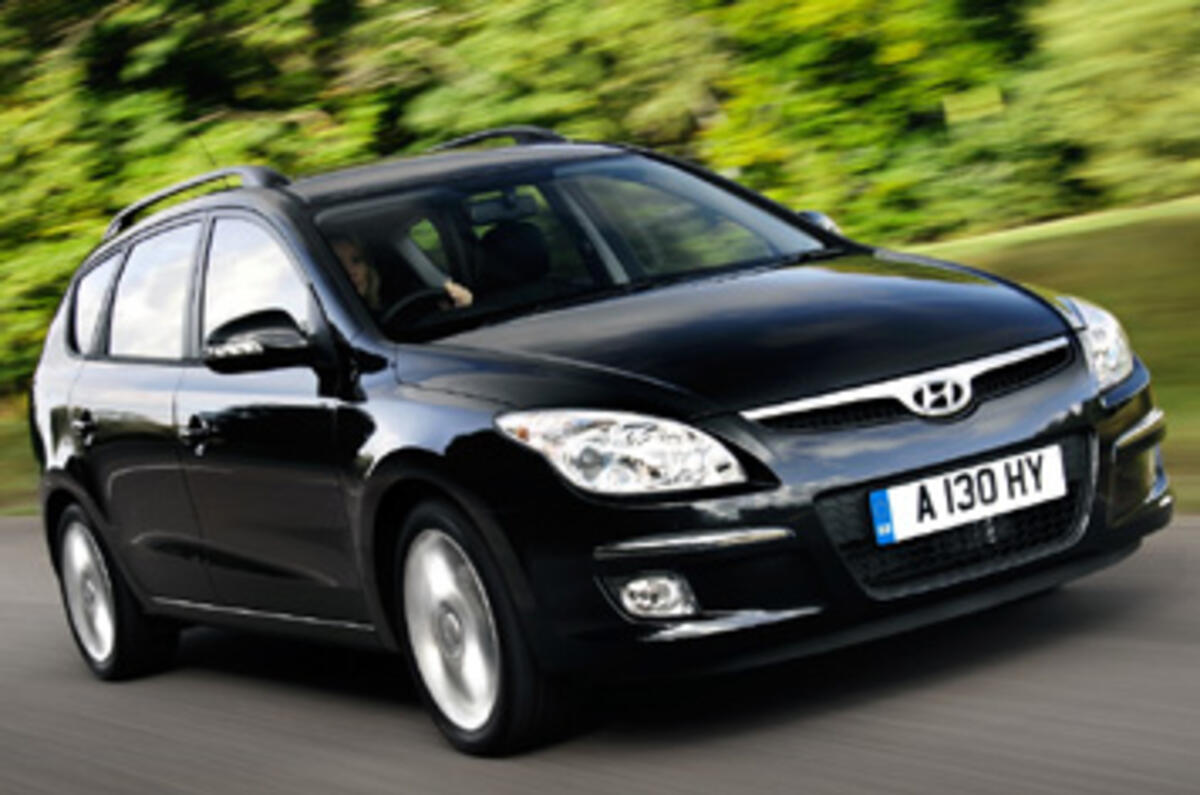What is it?
It’s the first Hyundai i30 Estate in the UK, a right-hook 1.6-litre CRDi Style with less than 200 miles on the clock. And we were the first journos to drive it.
Making a good small wagon these days takes more than a bit of extra glass and a cargo net. The new Hyundai i30 Estate proves that. On the outside, every panel from the B-pillar backwards is new, and that’s because the car’s got a longer wheelbase than the standard hatchback as well as a longer rear overhang.
It’s also got a bigger rear cabin than the five-door, and a bigger boot. A six foot passenger can comfortably sit behind a similar sized driver in this i30, without so much as brushing his knees against the seat back in front, and rear headroom is as good as that of a car from the class above.
There’s 415 litres of boot space with the rear seats up, but with them folded this car will accommodate 1395-litres of stuff; which is more than the last BMW 3-series Touring, in case you were wondering.
What’s it like?
The i30 Estate’s engine range is a little narrower than that of the standard hatchback. We drove the 113bhp 1.6-litre turbodiesel. It was refined, frugal, and yet punchy enough to shift the car’s heft without being worked overly hard. Matched to a set of spring and dampers tuned more for comfort than out-and-out road-holding, it makes this car feel like a very willing, capable, grown-up means of family transport.
It’s no less manoeuvrable for the extra length between the front and rear wheels (the top-spec Premium version comes with parking sensors for those worried about the extra bulk out back). If anything, it feels a little more stable and refined than the standard hatch, but hardly less agile.
And though both steering wheel and pedals feel a bit woollier and less precise than they would in a Ford Focus wagon or VW Golf, you can’t fault Hyundai’s levels of material quality or fit-and-finish.
Should I buy one?
Yes, for all sorts of reasons, but the best of them is price. A similarly-engined Ford Focus Estate costs more than £17,000; this car, with its automatic headlights, tyre pressure monitors, leather steering wheel – and five year warranty – is just £14,695.
That’s even better value when you consider that it buys a car that’s as roomy, refined, comfortable, punchy, well-built and easy-to-live-with as anything made by the mainstream volume car-makers.
Hyundai’s challenge has never been greater to those established European car-makers. The standard i30 extended that challenge; this more versatile version of the breed underlines it. And pretty soon, nobody – not even the likes of BMW, Audi and Mercedes-Benz – will be able to ignore it.



















Join the debate
Add your comment
Re: Hyundai i30 estate
I've now done 8,000 miles in the Hyundai estate, and the gearbox is getting slightly less notchy but going into 2nd can still be tricky, especially when cold. Its still on the factory oil, which I haven't had to top up yet (a nice change to VW's PD engines which typically drink up to a litre of oil between 10k services). Filling up with diesel happens every 550-600 miles, so usually bettering 50mpg on motorway work.
In terms of handling, the i30 estate has a longer wheelbase and higher body than the hatch, so I don't throw it round corners quite as enthusiastically as the old Golf which was a hatchback. Ride quality is about on a par with the MK4 Golf. The handling won't be as good as a MK5 golf though (which has superior multi-link rear suspension set up) but is still very good. The spring and damper setup on the estate is a nice balance, firm without being too harsh. In comparing with a Golf Estate, its worth mentioning that VWs have the same wheelbase and hence rear leg room as the hatchback equivalents, wheareas the i30 uses the longer wheelbase to provide more rear leg room.
I have had one more fault develop, although I think its actually been there from new - that of roll back on hand brake. Apparently the i30 has both disk and drum brakes at the rear - the foot brake stops you on the discs, so when the handbrake engages there is a small amount of play, which results in rolling back a couple of inches (or forwards, if facing downhill). This seems to be a design fault, according to the forums, but I'm going to take it in to be looked at, along with the fuel filler release which has got even more in intermittent of late.
In terms of Warranty, I haven't really had to test it in anger yet, but I'm told Hyundai covers more things on the i30 than Kia do on its sister car, the C'eed. The latter has a 7 year warranty, limited to 100,000 miles. According to the forums, regular servicing (12,500 intervals) with proof that the correct oils were used is essential to any engine related claim on Hyundai warranty. Corrosion of the alloy wheels is said to be a regular warranty claim. Not surprising, as Hyundai wheels are manufactured by the same OEM as Mazda's, and I've just had a full set replaced under warranty on my MX5 Mk3.
Hyundai also recently reduced the inclusive RAC cover on their new cars to 1 year (it used to be 3). I guess they have to cut corners somewhere.
Finally, the only other (very) minor niggle I've discovered is that the automatic boot light, linked to opening the tailgate, can't be separately disabled. Hence, if you don't shut the boot properly, you could end up flattening the battery......
Re: Hyundai i30 estate
M1, many for thanks for the comprehensive and detailed "first hand" experience of running of an i30 estate. Very useful to read.
Just a couple of questions:
- how does it compare to the mk5 Golf you had in terms of ride/handling? and
- how comprehensive is the 5 year Hyundai warranty?
Re: Hyundai i30 estate
Thanks for that, it gives a great insight into a car that I am seriously considering for my next 'work horse'.
Small necessities I can live with out!